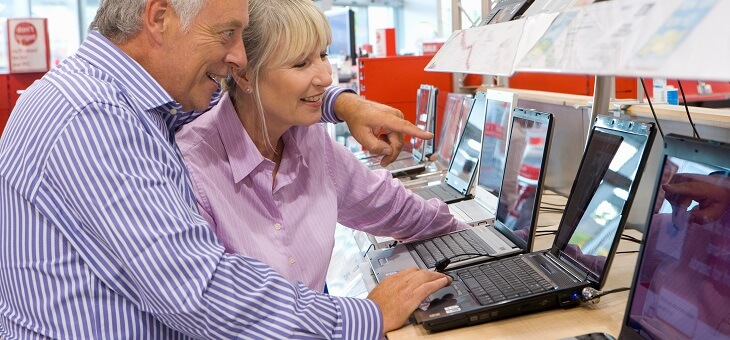There are a few things to think about when buying a laptop, from its price to its features, to its size. Whatever you’re looking there’s sure to be a laptop model to suit every taste and budget.
Much like mobile phones, once upon a time laptop computers were rare and mainly the domain of CEOs and IT experts. But today, the humble laptop has become almost ubiquitous.
With such a wide variety of models available, it can be confusing trying to work out which one to pick. But by following these tips
Windows or Mac?
One of the questions that most divides computer users is which operating system they prefer to use. It should probably be the first question you ask yourself when buying a laptop, as it will determine which models you have to choose from.
Read: Extend your laptop’s battery life
The principal divide is between those who use Microsoft Windows (available on many laptop models) and those using Apple’s macOS (compatible only with Apple computers).
This choice is mostly about what you’re used to using. If you’ve spent your working life using Windows, then you’ll probably gravitate towards what you know.
Although opting for an Apple laptop will limit your options to Apple computers, macOS is designed to work seamlessly with other Apple systems such as iOS (iPhones) and tvOS (Apple TV).
What do you want to do with it?
Once you’ve decided which operating system you want, take some time to work out what tasks you want to do with your laptop.
Read: Top tech tips to use your computer like a pro
If you just need to send a few emails and catch up on your social media, then a basic laptop will be suitable for you. But if you intend to push your laptop further, using it to play PC games or edit videos, then you’ll need something with better (and more expensive) components.
Price
Like a lot of technology, laptops can generally be classified into ‘entry-level’ models, ‘mid-range’ and ‘high-end’ models, differing in price and features.
Entry-level
If you’re not looking to spend a lot of money and just need something to complete basic tasks, then an entry-level model may be for you. Typically, these will retail for under $500 and will be capable of basic tasks such as web browsing, email and word processing.
Read: How to enable voice typing on your computer
Like anything ‘entry-level’ though, you will struggle with more complex tasks such as video editing and playing games. You’re trading off these features for a lower price point.
Mid-range
As the name suggests, mid-range laptops are aimed at those who need a little more than the basic package, but don’t want to go overboard. In general, these models are aimed at those who use computers regularly, such as families and businesspeople.
Laptops in the $500-$1500 range are generally considered mid-range.
High-end
High-end laptop computers are for those who want the processing power of a desktop, with the portability of a laptop. These models usually contain the same internal components as their desktop brethren.
These types of laptops are for serious computer enthusiasts and come with a price tag to match. Expect to pay upwards of $2000 for models such as these.
If you enjoy our content, don’t keep it to yourself. Share our free eNews with your friends and encourage them to sign up.


If only it were this simple. Other very important things to consider include the real estate (size of the screen), ergonomics of the keyboard, battery life and connections.
If you intend using your laptop for your photos and wish to make smart albums, a 13 to 14 inch screen is a good size as this size laptop is still small enough to take travelling with you.
The smaller sized ones can be challenging to use when selecting photos or doing video editing (as most smart phones have quite creditable video functions, this is a fair consideration).
Anything over the 14 inch screen can be cumbersome and heavy if travelling with it.
Also the smaller screens can make reading and composing emails difficult to see.
Play with the key board and touch pad for a while as well. (Functioning of the touch pad can be varied quite a bit via System Preferences in Mac, the idea of a lap top is that you can work without a separate mouse, but you can always connect one via Bluetooth if that is your preferred cursor control.
Battery life can vary greatly with smaller laptops barely making 2 hours and yet the present Apple MacBook Airs and MacBook Pros are giving up to 18 hours of independence.
I’ve been using MacBooks and MacBook Pros for over 10 years now and the Photos and IMovie are included (as is their Pages word processing application and Numbers their spread sheet application) for no additional cost.
If you have an Apple iPhone, all photos and videos can be transferred over in seconds without needing cables.
Memory is also an important consideration. The larger the HDD the better as this is where your photos and videos and documents will be stored. Always aim for the largest HDD that you can afford as it will fill as you take and save photos and receive emails from your families and friends.
I have around 20 thousand photos in Photos and have edited over 200 videos and uploaded them to my YouTube channels and at present I am still using a MacBook Pro that is over 10 years old (yes, I did upgrade the HDD to a 2 terrabyte SSD) and this machine does all that is needed of it.